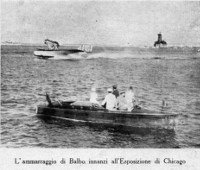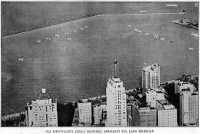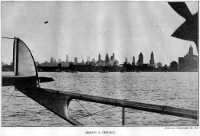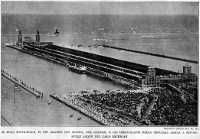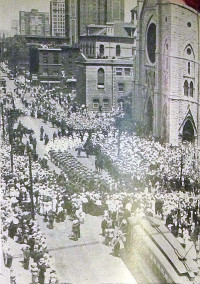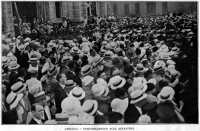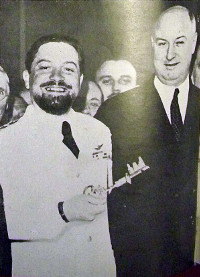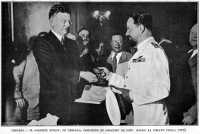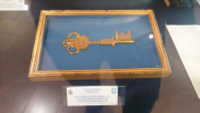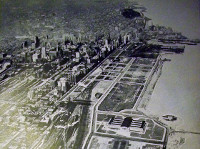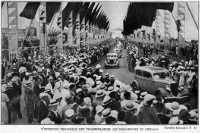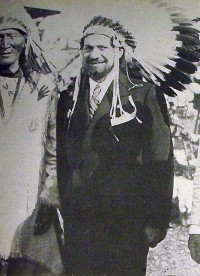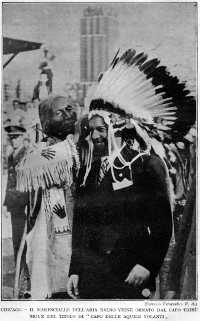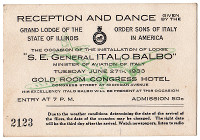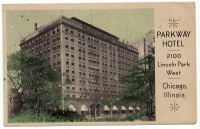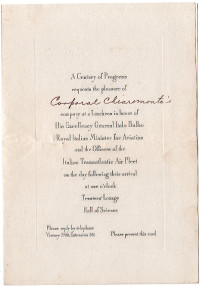 |
 |
 |
 |
 |
 |
 |
 |
 |
||||||||
Preparations Forward flight
1 - Orbetello - Amsterdam Return flight
9 - New York – Shediac Epilogue |
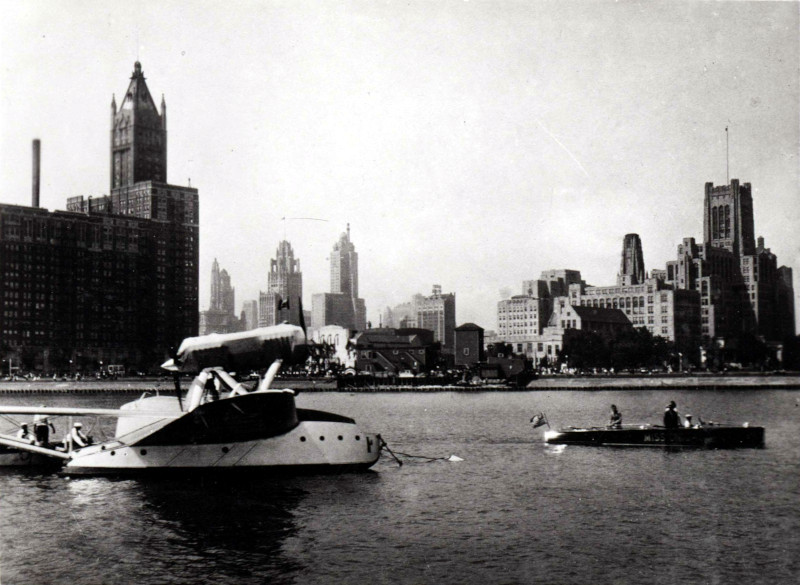 In the image the seaplanes in front of the skyscrapers of Chicago [on concession of the museum AM of Vigna di Valle].
In the image the seaplanes in front of the skyscrapers of Chicago [on concession of the museum AM of Vigna di Valle].Official statement of 1933: "The second Atlantic Air Squadron, which had started the Montreal-Chicago stage at 4.14 pm, and which had been sighted later in Kingston, on Lake Ontario, at 18.7, on the north shore of Lake Simcoe at 19.5 pm, at Owen Sound (Georgian Bay, on Lake Huron) at 8.20 pm and on Port Wayne at 10.30 pm, it was spotted in the sky at 11.23am in Chicago and completed the ditching of all the 24 devices at 0.14. 4th Report to the Duce When I arrived in Chicago, I fulfilled the mission that had been entrusted to bring a message of friendship from Mussolini's Italy to the great American people on the occasion of the World Exhibition of the Century of Progress. In the first part of the flight, from Orbetello to Chicago, 11.300 kilometers were traveled. The second part concerns the return to Europe, but the return flight has different characteristics from the one made so far. I can now briefly take a look at the flight from Italy to Chicago, examining some more interesting details. I must certainly say that this second mass crossing of the Ocean has exceeded my expectations: cars and men have really lived up to it. of the situation. When you consider that in fifteen days from Italy to Chicago forty-eight engines have not lost a beat, have not had a single "panne", we can not but appreciate the goodness of our material. Of the seaplane I must make the same ample praise: it is an apparatus superior to the technical progress of our days. Being collective flights in formation, we require in the personal qualities and attitudes far more remarkable than in individual flights: my men do not represent, however, in the Italian aviation anything exceptional. They come from the normal employment departments: I have imposed on them only an adequate period of preparation at the Orbetello High School of Navigation. The pilots of this cruise have so far fulfilled their task. For my part I had to stop some impatience during obligatory stops, when I was asked to leave at any cost; naturally I did not take any account of these youthful exuberances which proved to me more with sentiment than with words. The public does not have an idea of ??the enormous physical weariness of the hydroplanes. When the machines have landed and are moored in the bases of landfall, the most serious effort begins, because we must immediately provide for supplies. These are thousands and thousands of kilograms of fuel to be poured into the tanks, of large quantities of oil to be loaded into small cans, a very tiring operation that requires hours and hours of work. Seaplane commanders, not unlike the masters of ships, are required to preside over all on-board operations. The Atlantic flight has undoubtedly still a lot of fascination in the eyes of the populations. The Atlantic is now defeated by aviation, but we must not forget that there are some Atlantic sectors in which flight is still extremely difficult. Our stage from Iceland to Labrador was tough: we flew for three hours immersed in the fog. On leaving I was aware of the situation: I knew that after Greenland we would have met more favorable weather conditions. My concern during the blind flight was to keep the various squadrons detached: for this purpose they made invaluable services the radio and the radiogoniometer, which were the precious instruments of our success. To give an idea of ??the importance of these tools I could remember, for example, that my radio operator had to transmit and receive for fifty minutes during every hour of the flight. Our little radios, built by the technical direction of our Aeronautics direction, are wonderful; I believe that they represent a significant advance on the best existing stations today. I have said that our route over the North Atlantic has been hard: it is in no way comparable with the South Atlantic routes. With equipment like ours, which can fly at great speed, you can make the crossing from Africa to South America from dawn to evening: the flight in the South Atlantic becomes so easy and almost easy. In the flight across the North Atlantic, in addition to the fog which is a serious obstacle especially for collective flights, there is the danger of ice formation on the wings due to low temperatures. So far, however, the greatest concern of the flight has been given to me by the apparatus of the American filmmakers who have come to meet us on our way to Cartwright, throwing us imprudently into our training. Speaking of the base for the North Atlantic flights, I can not fail to mention that Reykjavik Bay is a wonderful base for the admission of an air crew, wide and safe in every respect. The success of our flight is due in large part to the excellent organization of our meteorological service. We had at our disposal two submarines of the Italian Navy, two lookouts and the whalers with Italian radio-telegraphs on board. The whalers have moved up to a hundred miles from the seaplane route to study winds and atmospheric conditions. Our information was controlled and therefore reliable. We also had the collaboration of the Danish meteorological services and the international organization of the polar year. Exact knowledge of time is essential for the success of these great flights. In the Atlantic route such atmospheric variations occur and such changes that can hardly be imagined. For example, between the departure point and the arrival point, a barometric difference of 11 mm occurred during our flight. I could make a stop in Greenland: I avoided this stop because I think it is more brilliant a unique stage that, among other things, avoids the risk of being bottled in Greenland, where especially in the southern part the weather conditions are very variable. About the speed reached by the equipment during the first part of the Cruise, I can say that, as I had foreseen, the average was generally about 220-225 Km. During the Atlantic crossing, due to the strong winds with trares, we kept the average over 200 Km., In other stages we had an average of 250 Km. Along the route, wherever people welcome us with an enthusiasm that deeply moves us. This persuades me that the importance of our companies is perfectly understood all over the world. From Europe to Labrador, from Labrador to Canada and from Canada to Chicago, ours does not appear to be a "raid" in the old sport sense. The public has understood that it is the world that walks, it is the new soul that everyone takes and pushes us towards progress, towards the new human conquests. The Italian aviation, rather than performing military maneuvers in Europe, came here to America to bring a friendly greeting, fulfilling a civil mission. As a consequence of the great progress achieved, the Aviation can, like the Marines, perform cruises on all seas and carry out important civilian missions, Italy has given it the first example. How was this possible? Italian aviators are soldiers in the service of a nation that has a great chief animator: Mussolini. I owe to him, to his precious orders if I knew how to brake the nerves and wait for the right moment for the departure of the Cruise and I owe to him too, to his fascination as a leader my unshakable faith in victory. Mussolini, from Rome, inspires and propitiates the tricolor wings that carry everywhere the thrill of His great heart and His great mind, tending towards the ideal of a new world more prosperous for all, more human, more powerful. Italo Balbo" | |||||||||||||||
